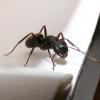My Carpenters exited diapause a week ago. After watching them closely, I've learned a couple new things about their behavior.
First, my ants appear to be "re-learning" the layout of their colony. It makes sense to me now, but I never thought about it before. All of their pheromone trails and colony odors would have faded in the 90+ days since they huddled together and sealed off chambers for diapause. It's interesting watching ants make a left turn, get confused, turn back, finally go right, and follow galleries that used to be high-traffic corridors where everyone knew where to go. They explore everything tentatively all over again, finding their outworld all over again. To the workers, it's a whole new world--Aladdin style. It's really interesting.
Second thing is the unusual way they take out all of the brood and scatter the larvae evenly across the surface area of their old brood chambers. Traditionally, larvae would have been densely piled on each other, but at first, the workers seem to keep each larvae separate. Wonder why they do that? Some ideas that I've come up with include:
1) Inspection of individual larvae for disease and cleanliness, keeping everyone safely separate
2) The ants have lost the scent markers for their old brood piles, and initially don't "know" where to pile up everyone (so every worker makes her own private choice about placement, and eventually converge on locations by consensus)
3) Some combination of the two, or something else
What have other folks noticed about ants coming fresh out of hibernation/diapause?














